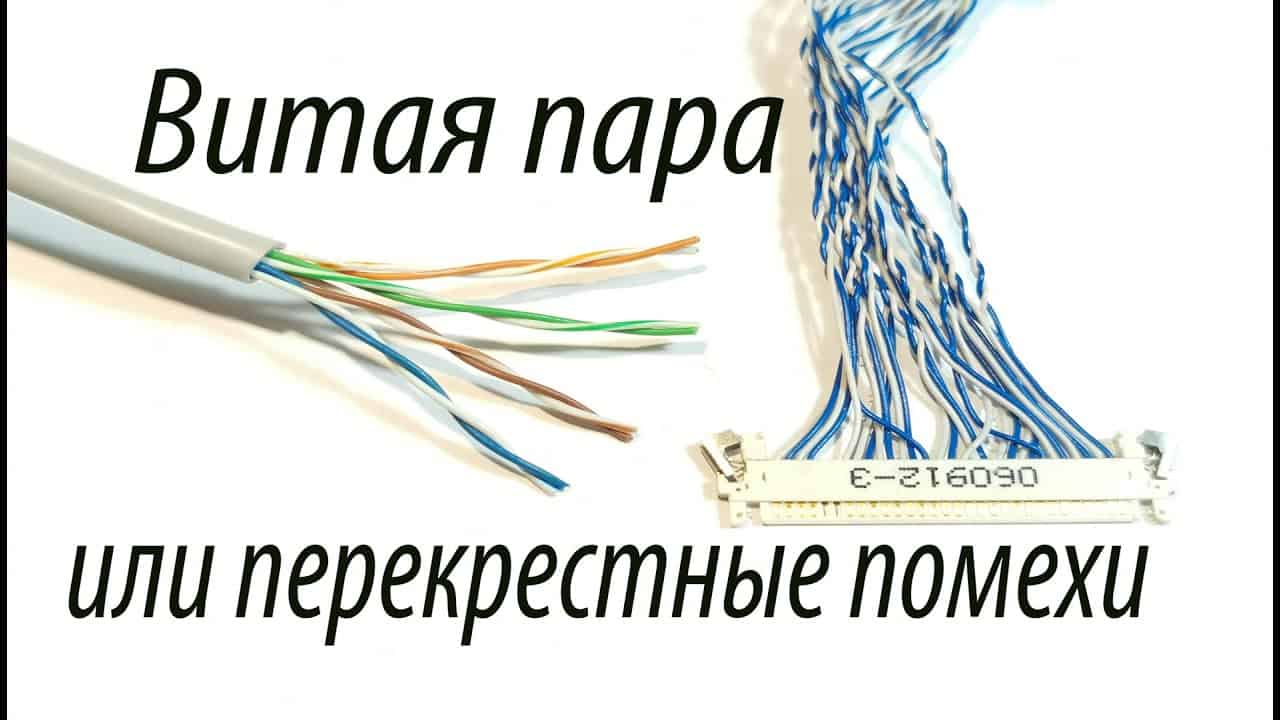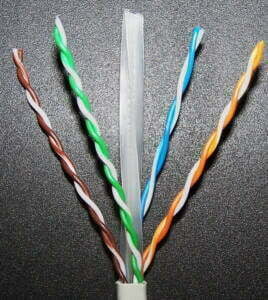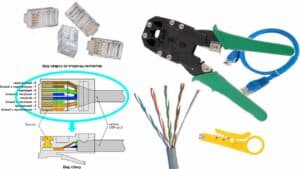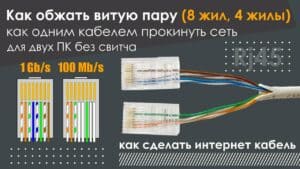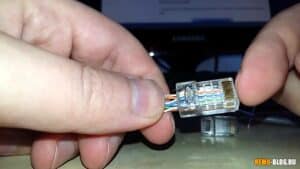The number of wires in a twisted pair has a direct impact on the quality of data transmission. The more wires, the more stable and reliable the connection between devices will be. At the same time, an excessive number of wires can lead to unnecessary complexity and costs for installation and operation.
A standard twisted pair cable uses 4 wires that are divided into 2 pairs. One pair is used to transmit data, and the second is used to receive. This configuration provides a fairly high data transfer rate and is suitable for most tasks.
However, more complex systems and high-speed interfaces such as Gigabit Ethernet may require the use of a more powerful 8-wire twisted pair cable. In this case, each pair is used to transmit and receive data in two directions, which provides higher speed and reliability of communication. In general, the choice of the number of wires depends on the required data transfer rate, the complexity of the system and the budget for installation and operation. With the right approach, you can achieve the optimal balance between communication quality and cost.
What is twisted pair and how does it work
A twisted pair is a set of two or more conductors that are twisted together to reduce the impact of external interference on data transmission. The number of conductors in a twisted pair can range from two to several dozen.
Each conductor in a twisted pair has its own color, which allows the wires to be distinguished. One conductor in a pair is positive, and the other is negative. When a signal is transmitted through the wires, they change their polarity, creating an electromagnetic field. Twisting the conductors reduces the amount of emitted interference and improves the quality of data transmission.
Twisted pair cable is used to transmit data in computer networks, telephone lines and other electronic devices. Network cables often use Category 5 or higher twisted pair cables, which provide high data transfer speeds and reliable connections.
As a result, the use of twisted pair is an important element in data transmission technology. It allows you to reduce the amount of interference and ensure high-quality information transmission.
The differences between 2, 4, 6 and 8 wire twisted pair cables lie in their ability to transmit data. The more wires in a pair, the more information can be transmitted simultaneously. For example, a 2-wire pair is used to carry analog signals such as audio, while 4, 6 and 8 wire pairs are used to carry digital signals such as Ethernet or HDMI.
In addition, the number of wires also affects the data transfer speed. The more wires in a pair, the higher the transmission speed. For example, a 2-wire pair can transfer data at up to 10 Mbps, while an 8-wire pair can transfer data at up to 40 Gbps.
It is also worth noting that the number of wires in a pair also affects the cost of the cable. The more wires, the more expensive the cable. Therefore, when choosing a cable, you need to consider both data speed requirements and budget.
Ultimately, the choice of the number of wires in a twisted pair depends on data transfer speed requirements and budget. If transmission of analog signals is required, then a 2-wire pair is sufficient. If you need to transmit digital signals at high speed, then it is better to choose a 4, 6 or 8-wire pair, taking into account your budget.
Choosing the right twisted pair type for different tasks
When choosing a twisted pair for a specific task, several factors must be taken into account. One of the main criteria is the number of wires in a pair.
There are twisted pairs with 2, 4, 6, 8 wires, etc.
e. For example, Ethernet data transmission uses a twisted pair cable with 8 wires, where each pair of wires is used to transmit and receive data in both directions.
However, for simpler tasks such as telephone line signal transmission, it is sufficient to use a twisted pair cable with 2 wires.
In addition, when choosing a twisted pair cable, it is important to consider the cable length and operating conditions. For long cable runs and high signal frequencies, use twisted pair cable with higher data rates and less noise.
For example, to transmit signals over long distances between buildings, it is recommended to use twisted pair cable with shielding to reduce the influence of external interference.
As a result, the correct choice of twisted pair type for a specific task can significantly affect the quality of data transmission and the resistance of the cable to external influences.
Advantages and disadvantages of different types of twisted pairs
Twisted pair cables are the most common method of data transmission in networks. They consist of several conductors twisted together in pairs. There are different types of twisted pair cables, each with their own advantages and disadvantages.
One of the most common types of twisted pairs is UTP (Unshielded Twisted Pair). It consists of four pairs of twisted conductors without shielding. Its advantages are low cost and ease of installation. However, UTP has disadvantages such as poor interference protection and reduced data transfer rates over long distances.
STP (Shielded Twisted Pair) is a twisted pair shielded with foil or braid. It provides higher levels of interference protection and higher data transfer rates. However, STP is more expensive and more difficult to install than UTP.
FTP (Foil Twisted Pair) is a twisted pair cable shielded with foil. It is cheaper and easier to install than STP, but provides a higher level of interference protection than UTP.
SFTP (Screened Foil Twisted Pair) is a twisted pair cable that is shielded and protected from interference. It provides the highest level of interference protection and higher data transfer rates over longer distances. However, SFTP is the most expensive and difficult to install type of twisted pair cable.
The choice of twisted pair type depends on the data transfer rate requirements, the level of protection against interference, and the project budget. Twisted pair is a cable that consists of several conductors twisted together in a specific sequence and wrapped in a protective shield. It is used to transmit data in local area networks, both home and office.
Depending on the data transfer speed requirements, different numbers of wires can be used to create a twisted pair. For example, the most common twisted pair is a four-wire cable called 'UTP Cat5e'. It is suitable for most home and small office networks.
If a higher data transfer rate is required, then a cable with a larger number of conductors, for example, 'UTP Cat6', can be used. It has eight conductors and provides higher data transfer rates.
When choosing a twisted pair, you should also pay attention to its shielding. Shielding provides protection from external electromagnetic interference and helps improve the quality of data transmission. Twisted pairs can be shielded (STP) or unshielded (UTP).
Thus, when choosing twisted pair for a home or office network, it is necessary to take into account the requirements for data transfer speed and the level of cable shielding.
The Importance of Proper Installation and Maintenance of Twisted Pair Wire
Twisted pair is a cable made up of several wires twisted together into pairs. It is widely used for data transmission in computer networks, telephone lines and other communication technologies. Proper installation and maintenance of twisted pair cables are important to ensure reliable and fast data transmission.
Proper twisted pair installation includes proper cable placement, checking cable quality, and using shielded cable if necessary. When installing a cable, factors such as cable length, data transfer speed, and signal quality must be taken into account.
Twisted pair cable maintenance includes checking the cable for damage, replacing damaged sections, and cleaning the contacts. Regular maintenance helps prevent possible data transmission problems and extend the life of the cable.
Knowing how to properly install and maintain twisted pair cables is essential for anyone working in the networking industry. It helps ensure fast, reliable connections between devices and reduces the likelihood of data transmission issues. To ensure stable network operation, it is important to understand that twisted pair cables are not a single wire, but a pair of wires twisted together. Typically, a twisted pair of eight wires (four pairs) is used, with each pair having its own color: blue, green, orange, and brown.
Twisted pair is one of the most common types of cables used to transmit data in computer networks. It provides high data transfer rates and protects the signal from interference and electromagnetic influences.
However, to avoid problems with twisted pair cables and ensure stable network operation, several important factors must be taken into account. First of all, you need to properly install and configure your network equipment so that it meets the cable requirements.
In addition, you need to make sure that the entire cable system is properly twisted and placed. For example, if the cable is too long or has many bends, this can lead to poor signal quality and data transmission errors.
You should also keep in mind that different types of cables may have different data transfer rates, so you need to choose a cable that meets the requirements of your network.
In general, a correctly installed and configured twisted pair cable will ensure stable network operation and high data transfer speeds. Remember to monitor the condition of your cables and update them if necessary to avoid network problems.
Tips for installing and maintaining twisted pair cables
Twisted pair is a cable consisting of several pairs of wires twisted together. This type of cable is one of the most common for transmitting signals in local computer networks.
When installing and servicing twisted pair cables, a number of rules must be observed:
1. Mark the cable correctly. It is necessary to mark each pair of wires so as not to confuse them during installation.
2. Twist the wires correctly. Twisted wires create a magnetic field that can affect the quality of signal transmission. To reduce this influence, it is necessary to twist the wires at an equal distance from each other.
3. Use quality connectors. Poor quality connectors can lead to signal loss or even complete interruption of transmission.
4. Keep the cable length within the permissible limits. For twisted pair, there is a limit to the cable length that can be used without losing signal quality. For 100 Mbps networks, the maximum length is 100 meters, for 1 Gbps - 55 meters.
By following these simple rules, you can make the most of twisted pair cables and ensure stable data transmission on your network.
Read further:
